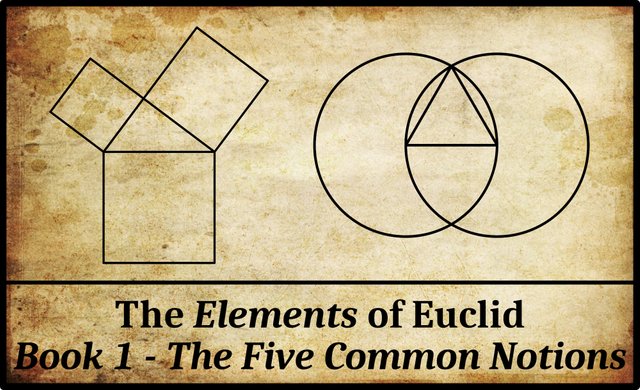
In Book 1 of the Elements, following the Five Postulates, Euclid states five Common Notions, or Κοιναὶ ἔννοιαι [Koinai ennoiai] (Fitzpatrick 7):
| Greek | English |
|---|---|
| αʹ. Τὰ τῷ αὐτῷ ἴσα καὶ ἀλλήλοις ἐστὶν ἴσα. | 1. Things equal to the same thing are also equal to one another. |
| βʹ. Καὶ ἐὰν ἴσοις ἴσα προστεθῇ, τὰ ὅλα ἐστὶν ἴσα. | 2. And if equal things are added to equal things then the wholes are equal. |
| γʹ. Καὶ ἐὰν ἀπὸ ἴσων ἴσα ἀφαιρεθῇ, τὰ καταλειπόμενά ἐστιν ἴσα. | 3. And if equal things are subtracted from equal things then the remainders are equal. |
| δʹ. Καὶ τὰ ἐφαρμόζοντα ἐπ ̓ ἀλλήλα ἴσα ἀλλήλοις ἐστίν. | 4. And things coinciding with one another are equal to one another. |
| εʹ. Καὶ τὸ ὅλον τοῦ μέρους μεῖζόν [ἐστιν]. | 5. And the whole [is] greater than the part. |
Much nonsense has been written about Euclid’s Common Notions and their relationship to his Postulates. Let us, therefore, state at the very outset what I believe to be the true state of affairs:
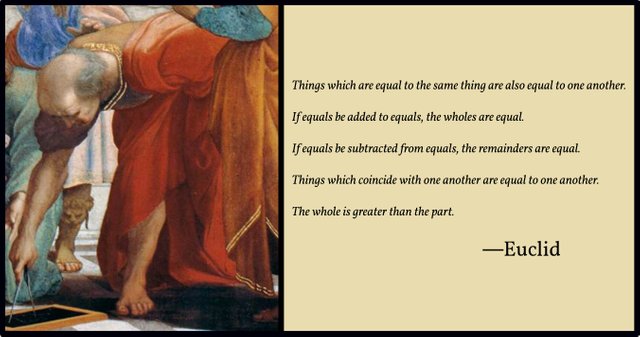
Euclid’s Postulates and Common Notions are axioms. That is, they are statements whose truth we must accept without proof. They provide us with a foundation on which to erect our proofs of important theorems or propositions.
The distinction between the Postulates and the Common Notions is simply the extent of their application. The Five Postulates apply only to Euclidean geometry. In a sense, they define Euclidean geometry—which for Euclid was the only geometry. The Common Notions, on the other hand, apply to all branches of mathematics, and even to the other sciences. The Common Notions are used to regulate all forms of logical reasoning.
This is what Euclid’s word common means. Not that these notions are commonly or widely accepted because their truth is more obvious than the truth of the Postulates, but rather that they are common to all the branches of science and mathematics.
The Common Notions are, in essence, fundamental laws of logic itself. David Joyce, however, makes an important point, which casts doubt on this interpretation:
These common notions, sometimes called axioms, refer to magnitudes of one kind. The various kinds of magnitudes that occur in the Elements include lines, angles, plane figures, and solid figures. (Joyce)
As we shall see below, Proclus believed that the Common Notions could be applied not only to magnitudes but also to numbers and intervals of time (Morrow 154).
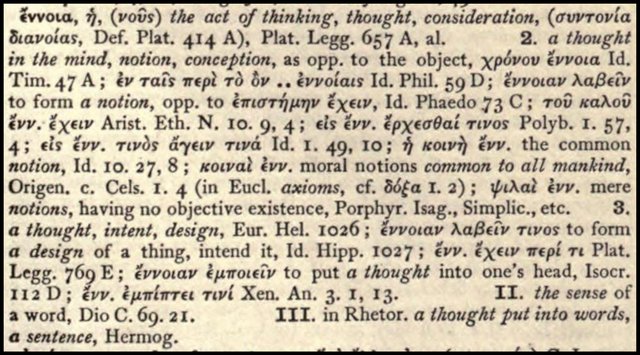
Authenticity
Euclid’s term ἔννοια means simply a thought in the mind, a notion, a conception. In English versions of the Elements it is usually translated with the word notion. In his 1582 translation, however, Henry Billingsley refers to Euclid’s Common Sentences.
The authenticity of the Five Common Notions has been questioned by variously scholars and on various grounds. One argument is that Euclid would never have used the word ἔννοια to describe what are essentially axioms. In 1884 the French mathematician Paul Tannery made a strong case for rejecting them on this ground. Thomas Heath summarized Tannery’s argument as follows:
In a paper Sur l’authenticité des axiomes d’Euclide in the Bulletin des sciences mathématiques et astronomiques [1884, Pages 162 ff] ... Paul Tannery maintained that the Common Notions (including the first three) were not in Euclid’s work but were interpolated later. The following are his main arguments. (1) If Euclid had set about distinguishing between indemonstrable principles (a) common to all demonstrative sciences and (b) peculiar to geometry, he would, says Tannery, certainly not have placed the common principles second and the special principles (the Postulates) first. (2) If the Common Notions are Euclid’s, this designation of them must be his too; for he must have used some name to distinguish them from the Postulates and, if he had used another name, such as Axioms, it is impossible to imagine why that name was changed afterwards for a less suitable one. The word ἔννοια (notion), says Tannery, never signified a notion in the sense of a proposition, but a notion of some object; nor is it found in any technical sense in Plato and Aristotle. (3) Tannery’s own view was that the formulation of the Common Notions dates from the time of Apollonius, and that it was inspired by his work relating to the Elements (we know from Proclus that Apollonius tried to prove the Common Notions), This idea, Tannery thought, was confirmed by a “fortunate coincidence” furnished by the occurrence of the word ἔννοια (notion) in a quotation by Proclus (p. 100, 6): “we shall agree with Apollonius when he says that we have a notion (ἔννοιαν) of a line when we order the lengths, only, of roads or walls to be measured.” (Heath 221)
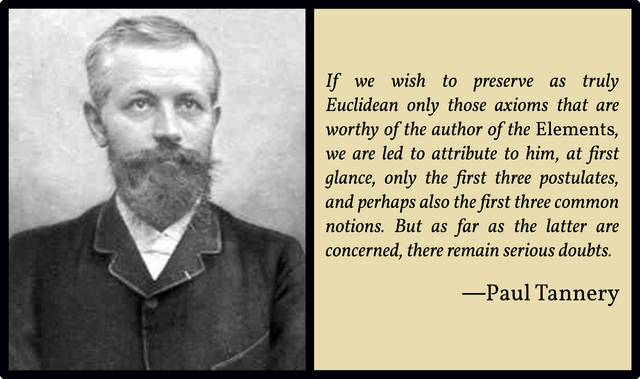
Tannery calls into question not only the Common Notions but also the Definitions and the Postulates:
If one were to consider Euclid’s Elements as a truly original work, it would be very difficult to admit the authenticity of the definitions, postulates and axioms which precede the propositions of Book I. The beginning is incontestably not of the same standard as that which follows it. Just as the arrangement of the problems and theorems of this Book testifies to a consummate art, as well as to a method powerfully conceived and systematically pursued in its development—albeit, perhaps, a little artificial—so the arrangement of the statements of the Introduction offers, where one should least expect it, incoherence and singular negligence. (Tannery 162-163, my translation)
Heath offers rebuttals for each line of Tannery’s argument, and sees no reason to reject the authenticity of the Common Notions. He does, however, concede that even among the ancients the rôle of and necessity for the Common Notions were disputed. Heron, for example, only accepted the authenticity of the first three Common Notions, Apollonius attempted to prove them, and Proclus referred to them as axioms (ἀξιώματα), not notions—though he did accept all five and even warned against any undue alteration in their number (Heath 222 : Morrow 140, 152, 154).
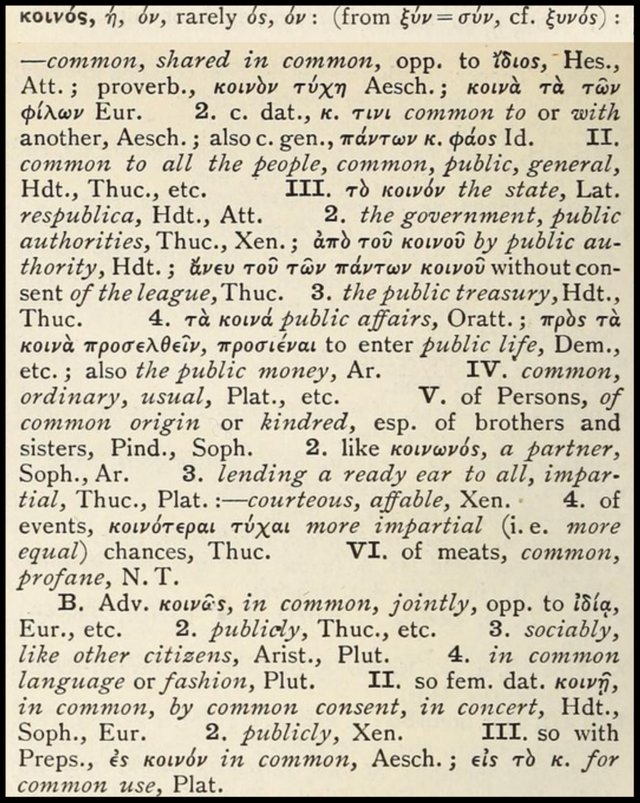
The adjective κοινός [koinos], which qualifies notion, means common. In Ancient Greek both of the following senses were valid:
- shared in common
- ordinary, usual, popular
I believe Euclid intended that the term be understood in the first of these senses: shared in common by all the sciences. But Proclus suggested that the crucial distinction between the Postulates and the Common Notions was the willingness of the student to concede these statements without proof:
When a proposition that is to be accepted into the rank of first principles is something both known to the learner and credible in itself, such a proposition is an axiom: for example, that things equal to the same thing are equal to each other. When the student does not have a self-evident notion of the assertion proposed but nevertheless posits it and thus concedes the point to his teacher, such an assertion is a hypothesis [ie definition]. That a circle is a figure of such-and-such a sort we do not know by a common notion in advance of being taught, but upon hearing it we accept it without a demonstration. Whenever, on the other hand, the statement is unknown and nevertheless taken as true without the student’s conceding it, then, he says, we call it a postulate: for example, that all right angles are equal. (Morrow 62-63)

And again:
It is a common character of axioms and postulates alike that they do not require proof or geometrical evidence but are taken as known and used as starting-points for what follows. They differ from one another in the way in which theorems have been distinguished from problems. Just as in a theorem we put forward something to be seen and known as a consequence of our hypotheses but in a problem are required to procure or construct something, so in the same way axioms take for granted things that are immediately evident to our knowledge and easily grasped by our untaught understandings, whereas in a postulate we ask leave to assume something that can easily be brought about or devised, not requiring any labor of thought for its acceptance nor any complex construction. Hence clear knowledge without demonstration and assumption without construction distinguish axioms and postulates, just as knowing from demonstration and accepting conclusions by the aid of constructions differentiate theorems from problems. (Morrow 140-141)
And finally:
These [ie the Five Common Notions] are what are generally called indemonstrable axioms, inasmuch as they are deemed by everybody to be true and no-one disputes them. (Morrow 152)

Despite these assertions, Proclus also seems to have recognized that the “axioms” were common in the other sense of that word:
These axioms are common, but each individual uses them with reference to his specific subject-matter and to the extent which his subject-matter demands. One man applies them to magnitudes, another to numbers, another to intervals of time. In this way, although the axioms are general, they lead to specific conclusions in each science. (Morrow 154)
Variations on a Theme
In his 1814 edition of Euclid’s Elements, the French mathematician François Peyrard lists no fewer than nine Common Notions. The first three and the last two correspond to those in modern editions. The remaining four are as follows:
| Greek | English |
|---|---|
| δʹ. Καὶ ἐὰν ἀνίσοις ἴσα προστεϑῇ, τὰ ὅλα ἐστὶν ἄνισα. | And if unequal things are added to equal things then the wholes are unequal. |
| εʹ. Καὶ ἐὰν ἀπὸ ἀνίσων ἴσα ἀφαιρεϑῇ, τὰ λοιπά ἐστιν ἄνισα. | And if from unequal things equal things are subtracted then the remainders are unequal. |
| Ϛʹ. Καὶ τὰ τοῦ αὐτοῦ διπλάσια, ἴσα ἀλλήλοις ἐστί. | And those things which are equal to twice the same thing are equal to each other. |
| ζ΄. Καὶ τὰ τοῦ αὐτοῦ ἡμίση, ἴσα ἀλλήλοις ἐστί. | And those things which are equal to half the same thing are equal to each other. |

Note that in the last two Peyrard uses the verb form ἐστί without the movable nu found in the first two: ἐστὶν. The use of the third person singular present indicative of εἰμί (to be) with a neuter plural subject is grammatically correct. In some manuscripts of the Elements, these two additional Common Notions are quoted in the proofs of Propositions 1:37 and 1:47 (the Pythagorean Theorem) . No doubt, it was because they were required for the proofs of these propositions that they were added to Euclid’s list of Common Notions (Fitzpatrick 37, 48).
In his critical notes at the end of Volume 1, Peyrard also records three more Common Notions that can be found in some manuscripts:
| Greek | English |
|---|---|
| ιʹ. Καὶ πᾶσαι αἱ ὀρθαὶ γωνίαι ἴσαι ἀλλήλαις εἰσί. | And all right angles are equal to each other. |
| ιαʹ. Καὶ ἐὰν εἰς δύο εὐθείας εὐθεῖα ἐμπίπτουσα τὰς ἐντὸς καὶ ἐπὶ τὰ αὐτὰ μέρη γωνίας δύο ὀρθῶν ἐλάσσονας ποιῇ, ἐκβαλλομένας τὰς δύο εὐθείας ἐπ᾽ ἄπειρον συμπίπτειν, ἐφ᾽ ἃ μέρη εἰσὶν αἱ τῶν δύο ὀρθῶν ἐλάσσονες. | And if a straight line falling on two straight lines make the interior angles on the same side less than two right angles, the two straight lines, if produced indefinitely, meet on that side on which are the angles less than the two right angles. |
| ιβʹ. Καὶ δύο εὐθεῖαι χωρίον οὐ περιέχουσιν. | And two straight lines do not enclose a region. |
Of these, the first two are Euclid’s Fourth and Fifth Postulates. The third is sometimes called Euclid’s Sixth Postulate, as it was sometimes added to Euclid’s five.

We also find Peyrard’s nine Common Notions, in the same order, in the first English translation of the Elements, which was brought out by Henry Billingsley in 1582.
In his 1826 edition of Euclid’s Elements, Ernst Ferdinand August has the first two of Peyrard’s four (δʹ and εʹ above) in place of Euclid’s fourth and fifth Common Notions.
When the Danish philologist Johan Ludvig Heiberg established the definitive modern edition of the Elements in the 1880s, he actually printed nine Common Notions but flagged four of them and only translated the five authoritative Common Notions into Latin (numbers I, II, III, VII and VIII in his numbering). His Common Notions IV, V, VI and IX are as follows:
| Heiberg | Greek | English |
|---|---|---|
| IV | Καὶ ἐὰν ἀνίσοις ἴσα προστεθῇ, τὰ ὅλα ἐστὶν ἄνισα. | And if unequal things are added to equal things then the wholes are unequal. |
| V | Καὶ τὰ τοῦ αὐτοῦ διπλάσια ἴσα ἀλλήλοις ἐστίν. | And those things which are equal to twice the same thing are equal to each other. |
| VI | Καὶ τὰ τοῦ αὐτοῦ ἡμίση ἴσα ἀλλήλοις ἐστίν. | And those things which are equal to half the same thing are equal to each other. |
| IX | Καὶ δύο εὐθεῖαι χωρίον οὐ περιέχουσιν. | And two straight lines do not enclose a region. |

Heiberg’s Five are now generally accepted as authentic, but even today the number and authenticity of the Common Notions are debated without any consensus having been reached. Most of the medieval manuscripts of the Elements list nine or ten (De Risi 301). In his study of this subject, the Italian historian of philosophy and science Vincenzo De Risi concludes that only three of them are genuinely Euclidean:
Since there is no consensus on the matter, I offer here a survey of the current evidence for the authenticity of Heiberg’s five common notions and some new grounds for debate. In particular, in §2 I offer textual arguments based on the reference to common notions in the propositions of the Elements as well as in indirect ancient sources. I show that, while CN1-CN3 are solidly embedded in the Euclidean text and often mentioned in the earlier Greek tradition, CN4 and CN5 are only tenuously connected with the text of the Elements and do not appear in other ancient sources before the fifth century CE. I conclude that the last two common notions are most probably spurious and I advance the conjecture that they were interpolated by Theon of Alexandria. (De Risi 302)
Theon of Alexandria published his edition of the Elements in the 4th century. Most extant manuscripts derive from his edition.
It is possible, then, that Heiberg’s “definitive” text of the Elements will one day be superseded by one which omits the fourth and fifth Common Notions.

And that’s a good place to stop.
References
- Ernst Ferdinand August, Euclidis Elementa, Part 1, Theodor Trautwein, Berlin (1826)
- Henry Billingsley (translator), The Elements of Geometrie of the Most Auncient Philosopher Evclide of Megara, John Day, London (1582)
- Richard Fitzpatrick (translator), Euclid’s Elements of Geometry, University of Texas at Austin, Austin, TX (2008)
- Thomas Little Heath (translator & editor), The Thirteen Books of Euclid’s Elements, Second Edition, Dover Publications, New York (1956)
- Johan Ludvig Heiberg, Heinrich Menge, Euclidis Elementa edidit et Latine interpretatus est I. L. Heiberg, Volumes 1-5, B G Teubner Verlag, Leipzig (1883-1888)
- Henry George Liddell, Robert Scott, An Intermediate Greek-English Lexicon, Harper & Brothers, New York (1889)
- Henry George Liddell, Robert Scott, A Greek-English Lexicon, Eighth Edition, American Book Company, New York (1901)
- Glenn Raymond Morrow (translator), Proclus: A Commentary on the First Book of Euclid’s Elements, Princeton University Press, Princeton, NJ (1970)
- François Peyrard, Les Œuvres d’Euclide, en Grec, en Latin et en Français, Volumes 1-3, Charles-Frobert Patris, Paris (1814, 1816, 1818)
- Vincenzo De Risi, Euclid’s Common Notions and the Theory of Equivalence, Foundations of Science, Volume 26, Issue 2, Pages 301-324, Springer Science+Business Media, Berlin (2021)
- Paul Tannery, Sur l’authenticité des axiomes d'Euclide, Bulletin des Sciences Mathématiques et Astronomiques, Series 2, Volume 8, Number 1, Pages 162-175, Gauthier-Villars, Paris (1884)
- Thomas Taylor, The Philosophical and Mathematical Commentaries of Proclus on the First Book of Euclid’s Elements, Volume 1, Volume 2, London (1792)
Image Credits
- Donato Bramante as Euclid: The School of Athens (detail), Raphael (artist), Stanza della Segnatura, Palazzi Pontifici, Vatican City, Public Domain
- Paul Tannery: Anonymous Photograph, Public Domain
- Xanthos in Lycia, Childhood Home of Proclus: © Haluk Comertel (photographer), Creative Commons License
- Remains of the House of Proclus (Dionysiou Areopagitou Street, Athens): © gus619USA (photographer), Creative Commons License
- Euclid: Proposition 1:47 (The Pythagorean Theorem): Codex Vaticanus Graecus 190, Folios 38v-39r, Vatican Apostolic Library, Vatican City, Public Domain
- Johan Ludvig Heiberg: Frederik Riise (photographer), Det Kongelige Bibliotek, Copenhagen, Public Domain
- Vincenzo De Risi: © Université Paris-Cité, Fair Use
Online Resources
